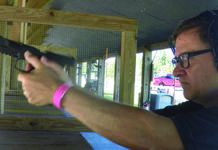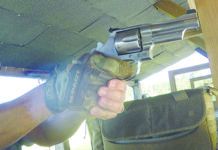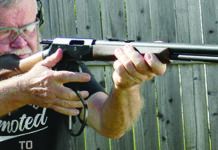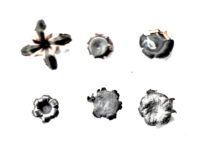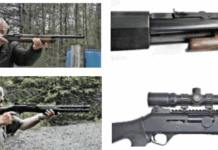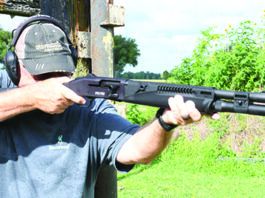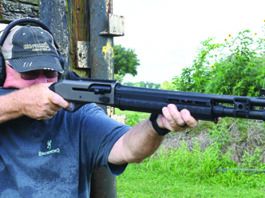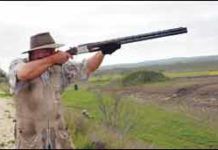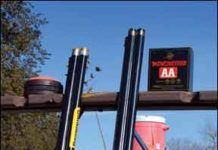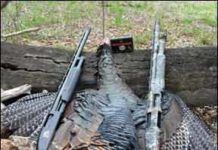Video: High-Capacity Shotguns Compared
Video: The Kel-Tec KSG 12-Gauge Pump in Action
Interchangeable Choke Tubes: We Pattern Seven Head to Head
Interchangeable choke tubes have been a feature for smokepole enthusiasts since Winchester Firearms created the system in 1959. The first experiment ended in 1965 because of functioning problems, but the Winchoke system introduced in 1970 took hold and is considered the grandfather of choke development. Today, it is hard to find a shotgun that does not feature some kind of interchangeable choke system.
Perhaps a little trip back to the physics classroom is necessary at this time. For those who still remember the days of Shotgun Chokes and Ballistics 101, we request a little indulgence.
When the powder charge sends the shot column down the barrel, it reaches the choke and is forced to squeeze together before exiting the muzzle. That constriction is called radial force. As the shot column leaves the barrel, gravity and wind resistance immediately take over and attempt to force the pellets inside the column to spin and flare off. The tighter the pellets are squeezed together by radial force inside the choke, the more the pellets hold together over a longer distance and produce a tighter pattern.
Constriction of the chokes is measured in thousandths of an inch and, in general, breaks down to the following measurements that are subtracted from the bore diameter of the barrel: Cylinder, .000; Skeet, .005; Improved Cylinder, .010; Modified, .020; Improved Modified, .030; Full, .040.
For example, in our patterning and handling tests, we selected a Browning Model XS Citori 12-gauge over and under with 32-inch barrels that was reviewed in previous editions of Gun Tests. The interchangeable chokes from the various manufacturers were all designed to fit the Browning. We checked the bore measurement of the XS with a bore gauge and the reading was .740. The constriction of all the choke tubes was subtracted from that figure to determine their bore diameter.
One more part of the classroom review states that in most cases the improvement in the pattern on a target at 30 yards over the widest pellet spread with a cylinder choke is about 10-13 percent with skeet; 15-17 percent with improved cylinder; 25-27 percent with modified; 30-33 percent with improved modified; and about 35 percent with a full choke. Students can now close their books.
It should be noted in reading through our test that performance results will vary depending upon individual shotguns and some shooters make their choke selection based on tube qualities other than patterning, such as ease of use; weight; and even appearance.
All of these individual factors are a matter of personal preference and help drive the quest to find the right combination of choke tube length and constriction that produces the optimum pattern performance. As one smoke-pole veteran said: "Whatever works for you, works for you — Don't mess with something that works."
In our test, we examined the results using both an improved cylinder and modified choke. The ammunition used was Winchester AA Xtra-Lite 2.75 inch Target Loads with one ounce of No. 71/2 shot and 2.75 dram equivalent of powder producing an average 1180 fps muzzle velocity.
All of the chokes in the test were fired at a 30-inch circle on a paper target placed 30 yards downrange. We noted that there was very little deviation in the overall pattern of pellet strikes on the paper, with all the chokes tending to produce slightly more strikes on the left side of the circle rather than on the right. This result probably is a factor of gun fit for the shooters, rather than choke fit in the barrel.
We also tested all the chokes on clay target presentations on a couple of different sporting clays ranges. While target breaks can vary according to the skills of the shooter more than because of the effectiveness of the chokes, we also used the "feel-good" factor to judge how well the tubes worked on clays in our evaluation.
FN Police Shotgun No. 17674 12 Gauge Pump
Winchester Super X Pump available in 12 Gauge
Repairing Ejectors On The Browning Citori
These specialized shotgun parts fall prey to several common mechanical malfunctions. Here's how to correct them.
H&R Topper Trap No. SB1-30T 2.75-Inch 12 Gauge, $360
Servicing the Browning Citori
Introduced by Browning Arms Company in 1973, the Citori is a direct descendant of John M. Browning's Superposed, the great gun inventor's last invention. The first Superposed models produced by Fabrique Nationale in 1930 had double triggers, one for each barrel. Browning's son, Val A. Browning, eventually redesigned the gun to have a single selective trigger, which allowed firing either barrel first by moving a thumb selector mounted in the receiver. The present day Citori and the Superposed—models of which are still available from Browning's Custom Shop—are practically identical, which is just further proof that John M. had few if any equals when it came to designing guns.
Two Visions of the Citori O/U: The New 725 Vs. the Older XS
Comparing Gun Checkering Tools
Checkering a stock is an art unto itself, and it requires hands-on experience to learn it. But we can show you some tools to use.
Turkey-Hunting Dilemma: Does A Thumbhole Give You an Edge?
For many turkey hunters, getting their hands on the right gear is almost as important as getting into the game of gotcha with a big tom. If the hunters think a new camouflage pattern, a different style of call, or an updated version of their favorite smoke pole will give them the edge over a wary tom turkey, they are all for adding the new piece of gear to their hunting ensemble.
[IMGCAP(1)]
One of the recent innovations catching the eye of more than a few hunters are shotguns featuring thumbhole stocks. This stock design lets the shooter place his or her thumb through the stock rather than wrap it over the grip, as rifle shooters have found. For scattergun enthusiasts, the concept is fairly recent and has received a relatively modest reaction.
We decided to check out two models of O.F. Mossberg and Sons Inc. turkey shotguns, one with a standard stock and one with a thumbhole stock, to see if there was a difference in performance and handling between the two popular turkey tools.
The two shotguns in our test were the Mossberg Model 500 No. 55216 Turkey THUG 12 Gauge with a suggested retail price of $409 and the Mossberg Model 500 Mossy Oak Break Up Synthetic Thumbhole Turkey pump-action 12 gauge with a suggested retail price of $493. According to Linda Powell, director of media relations for Mossberg, the thumbhole stocks are popular with steady sales, but make up a relatively small percentage of the many thousands of shotguns the company sells each year.
The various versions of standard, black synthetic, camouflage and other models of Mossberg pump-action shotguns are among the most popular firearms found in the hands of hunters across the country. It came as no surprise that the two models we put to the test lived up to the pump's reputation as a dependable and easily handling shooting tool.
As part of our handling and performance examination of the standard versus thumbhole stock, we selected several different types of popular shotgun ammunition. On the patterning board range, we used three different sizes of shot — Nos. 4, 5, and 6 — in 3-inch 1.75-ounce Winchester High Velocity Turkey Loads, all with an average muzzle velocity of 1300 fps. For overall handling and to test second- and third-shot capabilities, we switched to 2.75-inch Federal Game and Target shells loaded with 1 ounce of No. 7 1/2 shot, averaging 1290 fps at the muzzle. As noted in the comments below, recoil from the 3-inch shells in both shotguns was not particularly pleasing during the patterning tests. To reduce shoulder shock, lighter loads were brought into play for the multiple-shot review. Anyone who has spent much time touching off 3-inch shells at a patterning board can appreciate our decision. Here is our report:




